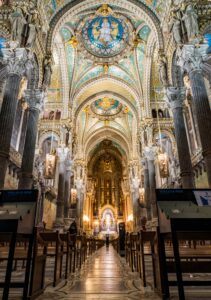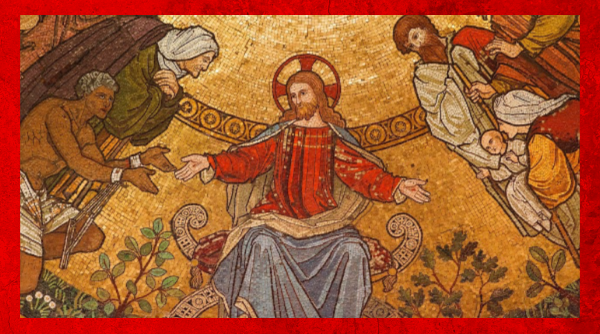Coming Face to Face with God: Using Images in Prayer

A common way of praying is through images. By use of our imagination, recalling images of sacred people and moments in salvation history gives us a tangible visualization to ponder in meditation. Asking God for the grace of understanding and to desire knowing Him more dearly, He will bless us with small moments of experiencing His love that leave us in awe. However, there comes a time in any relationship that, for it to go forward, deeper conversations must be held. These conversations require honesty, and being honest requires accepting vulnerability. And that is the hurdle to be overcome because of our image of God as our Father.
We bring into prayer our images of a human father or authority figure with whom we have had a relationship in the past and we think, “God must be like that”. For some people, those images may have been shaped by trauma they experienced from a father’s own trauma-generated behaviors. Sadly, abuse in all its forms is ‘passed down’ and becomes generational when the person does not seek our Lord’s healing. On the other hand, for many people their father may not have been abusive but, rather, simply ill-equipped to parent. As descendants of Adam, fathers are caretakers and providers by nature of being men. But providing spiritually for their family as providers of love can be difficult due to the concupiscence also inherited from our first parents.
In any situation, most fathers have not had role models that demonstrate true fatherhood to know what that ‘looks like’.
Because of this, developing a relationship with our Heavenly Father can be difficult. How can I be vulnerable in conversation with someone whose face I cannot even imagine? Scripture tells us God is love, but what does that look like? It may feel like you are talking to yourself in an empty room.
Yet our beautiful Catholic tradition (analogously) gives us aspects and attributes of our Father by which we can piece together an image. Paintings depict Him holding the world in His hand. Saints speak of His attributes, such as wisdom, compassion, omnipotence (all powerful), transcendence and omnipresence (available to all of creation); complete in His self-giving. Classic devotional prayers acclaim His goodness and love. Scripture tells us we were made in that image. Taking these qualities to prayer, God will give us understanding of Himself as Father. Rather than a visual image we see with the eyes, the image created is a spiritual one in the heart.
It is easier to pray with images of Jesus because He reveals to us the ‘face’ of the Father. It might be difficult, however, to image the real Jesus, the Divine Person who chose to take on our humanity. Since the 1970’s, modern images of Jesus sometimes are like a rock star or what Chris Stefanick once called “Hollywood Jesus”. At the same time, there was a move across most forms of Christianity to make Jesus more ‘accessible’ by portraying Him as a somewhat imperfect (but not sinful) human person. The thought was “Jesus suffered from xxx (addiction, intemperate anger, mindless acts, overeating, etc.) or at least was tempted to them so He understands me”. Notice how we are the center of this thinking rather than the Son of God! By faith we know the truth: to suffer temptation requires an inclination (vice) to that temptation which is derived from our concupiscence. While the devil tried to tempt Jesus, He Himself didn’t suffer temptation. This is the good news: while at the same time as revealing the face of God, Jesus is revealing to us the perfect integrity that our Father plans for us to have too! And although that perfection is fully attained through purgatory and lived in Heaven, our loving Father has always intended for us to live with some of this perfection now. When imaging Jesus, then, we look to His qualities that He wants us to share in: humility, compassion, mercy, justice for those treated unjustly, belief in Providence, and ongoing dialogue with our Father. All of these are forms of love and through the scriptures we see how He wants to give us this love right now in the present moment.

The most difficult to image is the Holy Spirit. Scripture gives us images like a dove or flames of fire. Perhaps, though, it is better to start with the beginning: God’s creative action in Genesis in which His Spirit moves above the water through the darkness bringing the Light of Glory into creation (Genesis 1:1-3). Allow that light of glory to move over the sea of darkness in your heart. Then envision a sensory image rather than a visual one. In the ongoing dynamic of love within the Trinity, the Holy Spirit is the love shared between the Father and the Son. We don’t as much see Him as we do sense Him, particularly His embrace as He lifts us up into that Trinitarian love.
When visual and sensory images (that are faithful to the truth of who God is) are used in prayer, powerful things happen because our very nature was designed to be loved by Him. He leads us gently into knowing Him and ourselves more intimately over time. The soul, humbled in love, can now have those honest conversations with Him. It is safe to be vulnerable.
Soon it will be Christmas and the God-Man will be born, giving us the most prolific image of vulnerability in love. Image that.
Ad Majorem Dei Gloriam 😊
(First published at SpiritualDirection.com )
(Images: woman in church by Cottonbro Studio, Pexels; church images by Ludovic Charlet, Unsplash)

Thank you for caring and sharing appropriately...
Consecrated to the Sacred Heart of Jesus through the Immaculate Heart of Mary. Except where noted, all design, writing and images ©2024 by Debra Black and TheFaceofGraceProject.com. All Rights Reserved. No part of this website may be reproduced, distributed or transmitted in any form or by any means, including downloading, photocopying, recording, or other electronic or mechanical methods, without the prior written permission of the publisher, except in the case of brief quotations embodied in critical reviews and certain other noncommercial uses permitted by copyright law. For permission or to report violations please email: thefaceofgraceproject@gmail.com
